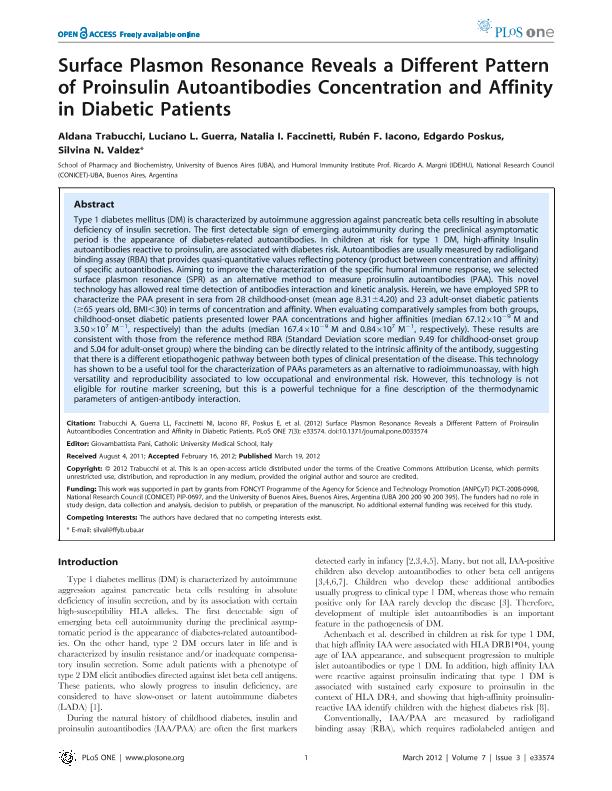Artículo
Surface plasmon resonance reveals a different pattern of proinsulin autoantibodies concentration and affinity in diabetic patients
Trabucchi, Aldana ; Guerra, Luciano Lucas
; Guerra, Luciano Lucas ; Faccinetti, Natalia Ines
; Faccinetti, Natalia Ines ; Iacono, Ruben Francisco
; Iacono, Ruben Francisco ; Poskus, Edgardo
; Poskus, Edgardo ; Valdez, Silvina Noemi
; Valdez, Silvina Noemi
 ; Guerra, Luciano Lucas
; Guerra, Luciano Lucas ; Faccinetti, Natalia Ines
; Faccinetti, Natalia Ines ; Iacono, Ruben Francisco
; Iacono, Ruben Francisco ; Poskus, Edgardo
; Poskus, Edgardo ; Valdez, Silvina Noemi
; Valdez, Silvina Noemi
Fecha de publicación:
03/2012
Editorial:
Public Library of Science
Revista:
Plos One
ISSN:
1932-6203
Idioma:
Inglés
Tipo de recurso:
Artículo publicado
Clasificación temática:
Resumen
Type 1 diabetes mellitus (DM) is characterized by autoimmune aggression against pancreatic beta cells resulting in absolute deficiency of insulin secretion. The first detectable sign of emerging autoimmunity during the preclinical asymptomatic period is the appearance of diabetes-related autoantibodies. In children at risk for type 1 DM, high-affinity Insulin autoantibodies reactive to proinsulin, are associated with diabetes risk. Autoantibodies are usually measured by radioligand binding assay (RBA) that provides quasi-quantitative values reflecting potency (product between concentration and affinity) of specific autoantibodies. Aiming to improve the characterization of the specific humoral immune response, we selected surface plasmon resonance (SPR) as an alternative method to measure proinsulin autoantibodies (PAA). This novel technology has allowed real time detection of antibodies interaction and kinetic analysis. Herein, we have employed SPR to characterize the PAA present in sera from 28 childhood-onset (mean age 8.31±4.20) and 23 adult-onset diabetic patients (≥65 years old, BMI<30) in terms of concentration and affinity. When evaluating comparatively samples from both groups, childhood-onset diabetic patients presented lower PAA concentrations and higher affinities (median 67.12×10 -9 M and 3.50×10 7 M -1, respectively) than the adults (median 167.4×10 -9 M and 0.84×10 7 M -1, respectively). These results are consistent with those from the reference method RBA (Standard Deviation score median 9.49 for childhood-onset group and 5.04 for adult-onset group) where the binding can be directly related to the intrinsic affinity of the antibody, suggesting that there is a different etiopathogenic pathway between both types of clinical presentation of the disease. This technology has shown to be a useful tool for the characterization of PAAs parameters as an alternative to radioimmunoassay, with high versatility and reproducibility associated to low occupational and environmental risk. However, this technology is not eligible for routine marker screening, but this is a powerful technique for a fine description of the thermodynamic parameters of antigen-antibody interaction. © 2012 Trabucchi et al.
Palabras clave:
Diabetes Mellitus
,
Autoantibodies
,
Surface Resonance Plasmon
Archivos asociados
Licencia
Identificadores
Colecciones
Articulos(IDEHU)
Articulos de INST.DE EST.DE LA INMUNIDAD HUMORAL PROF.R.A.MARGNI
Articulos de INST.DE EST.DE LA INMUNIDAD HUMORAL PROF.R.A.MARGNI
Citación
Trabucchi, Aldana; Guerra, Luciano Lucas; Faccinetti, Natalia Ines; Iacono, Ruben Francisco; Poskus, Edgardo; et al.; Surface plasmon resonance reveals a different pattern of proinsulin autoantibodies concentration and affinity in diabetic patients; Public Library of Science; Plos One; 7; 3; 3-2012; 1-7
Compartir
Altmétricas



